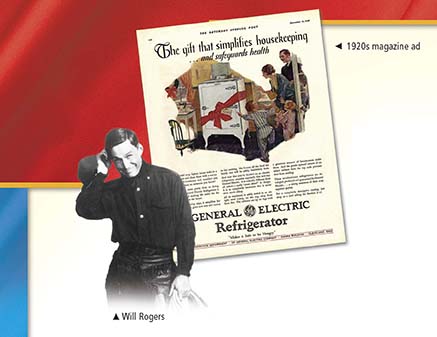SECTION 1: A Booming Economy

WITNESS HISTORY  AUDIO
AUDIO
Paying for It?
Folksy comedian Will Rogers was one of the most beloved entertainers of his day. Whether standing onstage twirling a rope or chatting on the radio, he could always be counted on to deliver good-natured, amusing comments on the American scene. In the 1920s—with the nation in the midst of a giant economic boom—Rogers turned his keen eye on Americans’ passion for buying things:
“No nation in the history of the world was ever sitting as pretty. If we want anything, all we have to do is go and buy it on credit. So that leaves us without any economic problems whatsoever, except perhaps some day having to pay for them. But we are certainly not thinking of that this early.”
—Will Rogers, radio commentary, 1928
Objectives
- Explain the impact of Henry Ford and the automobile.
- Analyze the consumer revolution and the bull market of the 1920s.
- Compare the different effects of the economic boom on urban and rural America.
Terms and People
- Henry Ford
- mass production
- Model T
- scientific management
- assembly line
- consumer revolution
- installment buying
- bull market
- buying on margin
NoteTaking
Reading Skill: Identify Supporting Details Note specific economic changes of the 1920s.

Why It Matters In the decade after World War I, the American economy experienced tremendous growth. Using revolutionary mass-production techniques, American workers produced more goods in less time than ever before. The boom fundamentally changed the lives of millions of people and helped create the modern consumer economy. Section Focus Question: How did the booming economy of the 1920s lead to changes in American life?
The Automobile Drives Prosperity
Rarely, if ever, has the nation enjoyed such an economic boom as it did in the 1920s. The recession that had followed World War I quickly ended. All signs pointed to economic growth. Stock prices rose rapidly. Factories produced more and more goods and, with wages on the rise, more and more people could afford to buy them.
Much of this explosive growth was sparked by a single business: the automobile industry. Carmaker Henry Ford introduced a series of methods and ideas that revolutionized production, wages, working conditions, and daily life.
Ford Pioneers Mass Production
Ford did not originate the idea of mass production, the rapid manufacture of large numbers of identical products. It had been used, for example, to make sewing machines and typewriters. But such products involved only hundreds of parts—not the thousands that go into the production of cars. Ford brought mass production to new heights.




